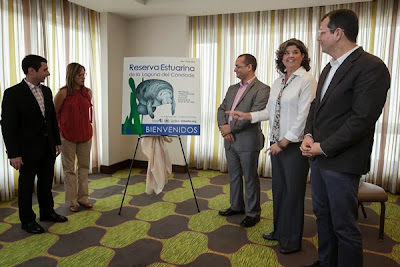Top 5 projects of the San Juan Bay Estuary Program for December 2013-January 2014
1) The Condado Lagoon Declared as an Estuarine Natural Reserve
We had yet another reason to celebrate: senator José Nadal Power (from left to right) Laura Vélez, President of the Environmental Quality Board, senator Ramón Luis Nieves, Carmen Guerrero, Secretary of the Department of Natural and Environmental Resources and Javier Laureano, Executive Director of the SJBEP held a press conference on December 16, 2013, to announce the designation of the first Estuarine Natural Reserve recognized by the local government.Read some of the ample news coverage of the event following the links:
http://www.noticias247.pr/index.php/salud/2981-declaran-como-reserva-estuarina-la-laguna-del-condado
2) Study to identify raw sewage and its link to public health in the SJBE’s watershed
The Environmental Protection Agency and the
Environmental Quality Board awarded the SJBEP a State Revolving Funds grant to
design and implement a study to identify critical areas of sanitary discharges
along the SJBE’s watershed, and its impact on human health.
On December the organization contracted Dr. José Seguinot Barbosa
and Dr. Rubén Hernández for the public health study, Roberto Morales for
geospatial analysis and mapping, and Ernesto Olivares for water quality
monitoring. During the first phase of the study, these professionals will
be drafting the research methodology and a Quality Assurance Project Plan
(QAPP) that will be submitted to EPA during the next months.
3) First public forum on community-based environmental activism in the San Juan Bay Estuary's watershed
 |
| Forum Attendees |
 |
| Juan Cruz speaks about Quebrada Chiclana |
http://estuario.org/index.php/89-noticias/555-primer-conversatorio-sobre-activismo-ambiental
4) ‘Estuario 360: limpia, siembra y monitorea’, a citizen science and restoration event
4) ‘Estuario 360: limpia, siembra y monitorea’, a citizen science and restoration event
 |
| Gustavo García, Julio Vallejo and Némesis Alejandra Ortiz |
On
December 7, 2013 the efforts of 130 volunteers in 15 locations— from Toa
Baja to Loíza— were coordinated to clean important waterways, plant native
trees and gather samples for water quality measurements.
 |
| Alberto Rodríguez, left, and Manuel Sanfiorenzo volunteer in Rio Piedras |
Volunteers can sing up at this link:
Below are some links to related news:
http://www.metro.pr/locales/
http://bit.ly/1d2rBoJ
Click on the link below for their stories and pictures!
5) 19 new actions proposed for the Comprehensive Conservation Management Plan (CCMP) of the San Juan Bay Estuary.
In an effort to keep up with a rapidly changing environment, we are currently revising the current SJBE management plan. As part of this process, 19 new actions were included for public consideration. Some of the new initiatives include the creation of green roofs and rain gardens in the San Juan metropolitan area, perform a detailed study of the ecosystem services provided by the estuary, and identifying the precise location of waste water discharge sites. You can find a complete list of the new actions in the link below and remember that we want to know what you think!We will receive comments to the newly proposed actions until February 28, 2014, please follow the link to view all proposed actions:
http://estuario.org/images/nuevasaccionesccmp.pdf








